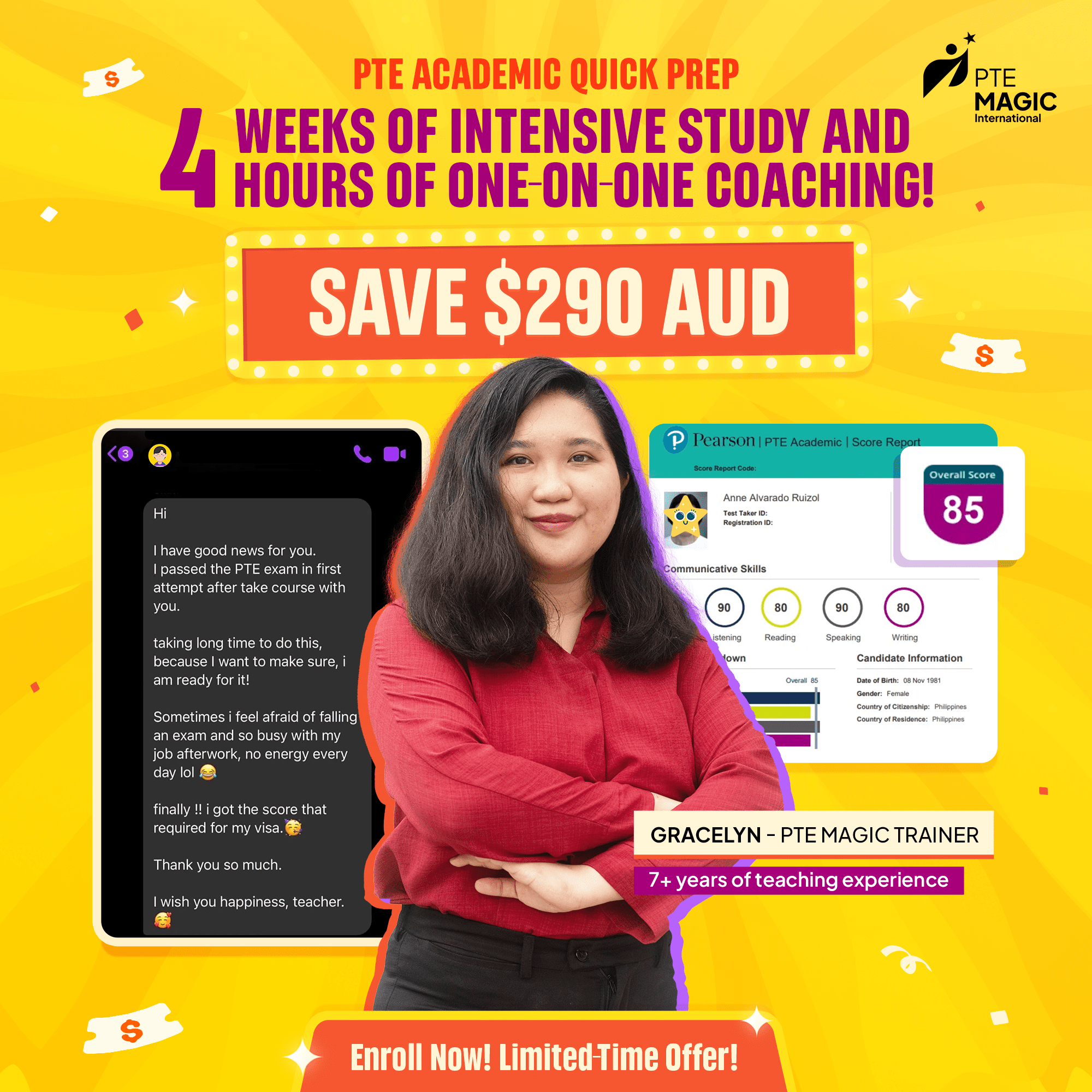No courses in the enrolment list.
This blog by PTE Magic is for teachers who want to start their PTE Academic teaching journey but don’t know where to start.
We will thoroughly introduce the test format and scoring system, strategies to help your students prepare for the test, and PTE Academic for teachers’ resources.
Scroll down to discover more!
|
How to FINALLY Pass the PTE and Achieve Your Dreams
Stop guessing! Start using proven methods that guarantee results!
✅ Master Every Section: Discover INSIDER SECRETS that secure HIGH SCORES. ✅ Save Time & Effort: Study SMARTER with proven strategies for FAST results. ✅ Real Practice, Real Confidence: Practice with TEST-LIKE questions to feel FULLY PREPARED.
START YOUR PTE SUCCESS JOURNEY TODAY
|
Key Takeaways
- PTE Academic is a two-hour test that assesses test-takers’ speaking, listening, reading, and writing skills in English.
- PTE Academic’s straightforward format focuses on measuring candidates’ proficiency levels, with three main sections including Speaking & Writing, Reading, and Listening.
- Teachers can use Pearson’s freely available lesson plans to make their teaching sessions more effective and exciting.
- Pearson’s online preparation course and collocations list are good resources for your teaching plans. See below for how to access them.
Related:
- The only PTE online course you need to pass the exam
- How to prepare for your next PTE test
Overview Of PTE Academic

The PTE Academic test is not just an English language proficiency exam but has also received more recognition from institutions globally. This test is the key to opening opportunities for anyone who wants to study, work, or settle abroad.
For learners, the PTE Academic is solid proof of their English academic skills which prepares learners for the challenges ahead in an English-speaking environment. This is why the test is also vital for teachers.
PTE Academic is a two-hour test that assesses test-takers’ speaking, listening, reading, and writing skills. Pearson uses AI and human expertise to produce accurate and unbiased results.
Below, we’ll briefly look into the test format and scoring system.
Test Format And Scoring System
PTE Academic’s straightforward format focuses on measuring candidates’ proficiency levels.
Three main sections of the test are:
Part 1: Speaking & Writing
This is the first part of the test, which takes between 54 to 67 minutes. Test-takers will need to do tasks that require them to express opinions and construct essays. There are 8 tasks in this section:
- Personal Introduction: This is the first task candidates will encounter in the test. It doesn’t contribute to students’ scores.
- Read Aloud: Students must read aloud the text of up to 60 words shown on the screen. Their answers are scored based on content, oral fluency, and pronunciation criteria.
- Repeat Sentence: This task requires test-takers to repeat the sentence in the audio recording lasting from 3-9 seconds. The scoring criteria are similar to the previous task.
- Describe Image: The candidate’s mission is to describe the image shown on the screen in 40 seconds. The scoring criteria remain the same as the previous tasks.
- Retell Lecture: Students must retell the lecture using their own words for up to 90 seconds. The scoring criteria remain the same.
- Answer Short Question: This task requires students to answer only one or a few words after listening to a short question of 3-9 seconds. The task will score their correct or incorrect answers, and inaccurate responses won’t get any credit.
- Summarize Written Text: Test-takers must write a summary sentence after reading the given passage up to 300 words. The scoring criteria for this task are content, form, grammar, and vocabulary.
- Essay: The goal is to write an essay of 200-300 words based on a given topic of 2-3 sentences. The task will evaluate the student’s abilities in content, structure, form, general linguistic range, grammar, vocabulary, and spelling.
Part 2: Reading
This part evaluates test-takers’ reading abilities, lasting for about 30 minutes. The PTE Academic test has five tasks in this section.
- Reading & Writing: Fill in the Blanks: Test-takers must choose the correct given word to fill in the blanks of an up-to-300-word text. This task applies a partial credit system, meaning students will earn points for the correct answers they complete.
- Multiple Choice, Multiple Answer: This task requires students to answer a multiple choice question by choosing more than one option. This task also applies partial credit scoring.
- Re-order Paragraphs: The students’ goal in this task is to reorder the text box on the screen into the correct order of the paragraphs. The scoring system is the same as the previous tasks.
- Fill in the Blanks: Candidates must drag the correct words in the given box to their respective blanks. This task uses the same scoring system as the previous ones.
- Multiple Choice, Single Answer: Unlike the Multiple Choice, Multiple Answer task, students can only choose one option in this task. The task will score candidates as correct or incorrect.
Part 3: Listening
The last part of the PTE Academic test takes up to 30 minutes, with 8 tasks in total.
- Summarize Spoken Text: Test-takers’ mission is to write a summary of 50-70 words based on the recording played. The scoring criteria for this task include content, form, grammar, vocabulary, and spelling.
- Multiple Choice, Multiple Answers: This task’s goal and scoring system are similar to the PTE Reading Multiple Choice, Multiple Answers.
- Fill in the Blanks: Students will see a transcript with missing gaps on the screen. They must fill the gaps with appropriate words by listening to the transcript’s audio. The content is the primary factor determining their scores here.
- Highlight Correct Summary: This question requires candidates to select the correct summary of a recording after listening to it. Students’ answers will be scored either as correct or incorrect.
- Multiple Choice, Single Answer: This task’s goal and scoring system are similar to the PTE Reading Multiple Choice, Single Answer.
- Select Missing Word: After listening to the recording, students must select the missing word from a list to complete it. They will be scored either as correct or incorrect.
- Highlight Incorrect Words: Test-takers’ mission is to find the words in the transcript given that are different from what they heard. This question applies to the partial credit system; each answer will be marked as correct or incorrect.
- Write from Dictation: This task requires students to write the sentence after listening to its recording. Their scores are based solely on the content criterion.
How To Help Your Students Prepare For PTE Academic?
Pearson offers a collection of freely available lesson plans for teachers. You can utilise these to make your teaching sessions more effective and exciting.
You should focus on test-taking strategies. Pearson recommends teachers plan each session around specific skills needed for different PTE Academic question types. These teaching plans will help you build strategy-focused lessons or broader test preparation classes.
The lesson plans should consist of around 20 lessons. Each lesson will cover three key strategies for a specific task. This is your map to identify the test’s structure step by step.
Here is a five-step approach to help your students prepare for PTE Academic:
- Step 1: You should start with the basics by introducing the question types. Showing screenshots of the tasks is also a smart method.
- Step 2: Pearson suggests teachers lay out the three essential strategies for each item type.
- Step 3: You should go deeper in this step. Provide detailed explanations of each strategy through activities and exercises for individuals, pairs, or groups.
- Step 4: This step is for testing the students. Require your students to answer under timed conditions similar to the exam format.
- Step 5: Compare their responses with sample answers. Show your students authentic explanations and teach them how to learn from those.
PTE Academic Teaching Resources
Official Course Books
Pearson’s official coursebooks offer all the important information for your teaching, ranging from test insights to practice strategies.
Pearson is currently providing these three-course books:
- Official Guide to PTE Academic: This book is considered the manual because it helps you understand the test structure, task types, and traits of a computer-based exam. You can find the “Official Guide to PTE Academic” book in eBook and print formats. We recommend it for teachers who want to build a solid study strategy for their students.
- Practice Test Plus: This is perfect for students who are ready to train themselves with mock tests. The book includes practice tasks, detailed guides, and strategies for every question. Additionally, it comes with a CD-ROM to boost your teaching plans more effectively.
- Expert PTE Academic: B1 & B2: It’s for teachers who want to focus on advanced practices. Aside from English, this course book can enhance learners’ awareness of the test. You can access Pearson’s MyEnglishLabs function to discover more digital practices for your teaching plans.
PTE Academic Online Preparation Course
Some teachers might feel confused when designing their PTE Academic study courses for students. This is why Pearson has prepared a free course outline PDF. The PDF mentions the crucial aspects, including the core English skills and sub-skills, to help teachers focus on the most essential part of the test.
Teachers can consider this PDF as their guide, as it also suggests which areas you should focus on for each class. This will help to ensure your class has a balanced and detailed approach that closely aligns with the test format.
To access this PDF, follow these steps:
- Step 1: Access the official Pearson PTE website
- Step 2: On the menu bar, point your mouse at “Partner & Research” and click “PTE for teachers.”
- Step 3: Scroll down till the end until you see the “Teaching and classroom resources” section. Click “Explore resources”.
- Step 4: At the “PTE Academic preparation course outline” part, click “Download prep course outline” to view and download the PDF version of the guide.
Academic Collocations
Collocations are word pairs that often go together to form frequently used phrases. They’re proof of fluent English proficiency. PTE test-takers who use collocations in the test will get better scores compared to those who don’t.
How do you teach collocations to your students? Check out the Academic Collocation List from Pearson. This is the ultimate guide to polishing learners’ language skills and also valuable material for PTE teachers to guide their students effectively.
Follow these steps to get the list from Pearson:
- Step 1-3: Similar to the steps mentioned in the section above.
- Step 4: At the “Academic collocations” section, click “Explore academic collocation” to view the post.
- Step 5: In the middle of the post, you will see the collocation list in two formats: PDF and Excel. Click on your preferred link to download the list.
The Bottom Line
PTE Magic hopes you can find the right PTE Academics for teachers’ resources on the Pearson website after reading this blog. Let’s keep working hard to fulfill our students and our dreams!
|
How to FINALLY Pass the PTE and Achieve Your Dreams
Stop guessing! Start using proven methods that guarantee results!
✅ Master Every Section: Discover INSIDER SECRETS that secure HIGH SCORES. ✅ Save Time & Effort: Study SMARTER with proven strategies for FAST results. ✅ Real Practice, Real Confidence: Practice with TEST-LIKE questions to feel FULLY PREPARED.
START YOUR PTE SUCCESS JOURNEY TODAY
|
Last updated on 10/03/2025

My name is Moni, and I am a seasoned PTE teacher with over 6 years of experience. I have helped thousands of students overcome their struggles and achieve their desired scores. My passion for teaching and dedication to my student’s success drives me to continually improve my teaching methods and provide the best possible support. Join me on this journey toward PTE success!



























I am a firm believer that the best teachers educate with their hearts not just their minds.
Moni | PTE MAGIC International Founder
Explore PTE
Tips & Tricks
If you’re planning to move to Australia, this checklist for moving to Australia as an...
Read more →Which is the best English test for Australian immigration? This blog will explain the importance...
Read more →How to find a job in Australia as an international student? This blog by PTE...
Read more →